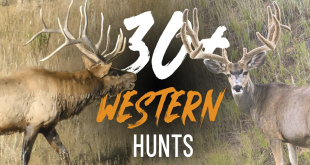It may seem like a ways off yet, but fall will be here before you know it. With fall comes antelope hunting and this past weekend we were reminded just how special a Boone & Crockett antelope buck is.
A gentleman from Wyoming came into the Salt Lake City ISE show on Saturday and asked the deer tour manager, Roger Selner, if he’d have time to score an antelope he shot with his bow last fall. Roger agreed and the hunter brought the buck back to the booth the next day. Immediately, we all started guessing as to what the buck scored and watched as Roger put the tape to him. When it was all said and done, the buck grossed 84-6/8 and netted 82-4/8. This buck was extremely deceiving as he has an enormous head, which made his horns appear smaller than they really were. Nonetheless a great trophy and one that is a truly special accomplishment.

To have some fun with it, we posted some trail camera photos the hunter had gotten of the buck over the course of the summer to our Facebook page and let our fans guess the score. We had scores ranging from low 60s to high 80s and even in the 90s. What this told us is exactly what we all know…antelope are extremely tough to field judge and score. Properly field judging an antelope is an art form and once you’ve mastered it, you have a huge leg up on other hunters. While many said this buck scored in the 60s and 70s, someone who knows antelope looks at it and understands it’s a B&C buck.

In order to get that coveted 80” antelope, a buck primarily needs great mass and length. Mass does way more to an antelope’s score than people give it credit for. A buck could be 16” tall and have great prongs and never make the book based on his lack of mass. Many guys get hung up on looking for super tall antelope. In fact, they should be looking for bucks with great mass and good length. The length of the horns is always a good base, and 15” is usually the benchmark for a buck to have what it takes to start a score heading toward 80”. However, the buck needs the right mass measurements to add onto that length in order to reach 80”.


Using the 4×7 rule (7” bases, 7” D2 measurements, 7” prongs and 7” total D3 and D4 measurements) can greatly increase your antelope scoring abilities. Pick up a copy of Mike’s best-selling book today on our store, to learn all the ins and outs of scoring antelope. This book also comes with a supplemental DVD that features a section on field judging.

 Eastmans' Official Blog | Mule Deer, Antelope, Elk Hunting and Bowhunting Magazine | Eastmans' Hunting Journals
Eastmans' Official Blog | Mule Deer, Antelope, Elk Hunting and Bowhunting Magazine | Eastmans' Hunting Journals




